Comments / Questions (12)
![]() Ann Joshage wrote:
Ann Joshage wrote:
Hej varför är början av vänstra sidan av era mönster borta? Oläs bar då hela texten inte kommer med.
07.10.2023 - 12:21
![]() Mary Nielsen wrote:
Mary Nielsen wrote:
Hej flot nederdel og elegant Ved afsnittet, hækle information 2 , hvad skal hækle for at for en spids mønster ved sidesømmen ? Skal jeg starte med 2 stgm i hver af de 2 sidste stgm ? Jeg har sand farve safran som jeg glædes til at lave den i . Please as soon as possible..tusind tak. Mary.
03.10.2023 - 15:16DROPS Design answered:
Hej Mary, jeg forstår ikke spørgsmålet... du får automatisk spidserne hvis du følger opskriften, zig-zag mønsteret starter ved 1.RÆKKE og alle rækker beskrives i opskriften :)
12.10.2023 - 15:43
![]() Lisbeth Høyer wrote:
Lisbeth Høyer wrote:
Forskyder den første stangmaske på en omgang sig ikke to fordi man slår 2 m om luft maske bue, hvad gør man så når man kommer hen til at man skal strikke de 3 m sammen og samtidig skifte farve til en ny omgang ?
26.08.2023 - 09:25DROPS Design answered:
Hei Lisebeth. Litt usikker på hvor du er i oppskriften, skriv gjerne hvilken rad du hekler ( og str. du hekler). Ta også en titt på hvelkevidoene som du finner nederst på oppskriften. mvh DROPS Design
11.09.2023 - 11:55
![]() Lisbeth Høyer wrote:
Lisbeth Høyer wrote:
Jeg havde glemt de 3 luftmasker, inden man begynder at hækle rundt.
24.08.2023 - 12:29
![]() Lisbeth Høyer wrote:
Lisbeth Høyer wrote:
Jeg har det samme problem ,når man begynder at hækle rundt som Christina, skal der ikke laves en bue af 3 luftmasker i samlingen, så det også bliver sik sak mønster der, det stemmer heller ikke med antal masker. Vil gerne se en nederdel bagfra med samlingen om muligt .
24.08.2023 - 12:01
![]() Aslaug Lerbæk Lerbaek wrote:
Aslaug Lerbæk Lerbaek wrote:
Jeg vil hekle skjørtet ensfarget - hvor nye garn da?
29.06.2023 - 17:13DROPS Design answered:
Hej Aslaug, det har vi ingen information om, men vi gætter at du skal bruge ca 500 g i de mindste størrelser og ca 700 g i de største størrelser :)
30.06.2023 - 09:03
![]() Tze Moi Ang wrote:
Tze Moi Ang wrote:
I finished my skirt and noticed the curly result (yellow stripe immediately after the waist band. Why is that and if I were to make another one, can I improve the design? And do you have other color combinations for suggestion? Thanks.
19.04.2023 - 11:53DROPS Design answered:
Dear Mrs Ang, you can block your skirt, ie spray water and let dry flat, this should help. Enjoy your skirt!
19.04.2023 - 13:11
![]() Cherry Lim wrote:
Cherry Lim wrote:
It would be very nice if this zig-zag pattern in the form of a dress with a slightly flared skirt can be created, similar to the knitted dress version :)
08.04.2023 - 17:55
![]() Christina Rasmussen wrote:
Christina Rasmussen wrote:
Hej med jer Når jeg begynder at hækle rundt, så siger opskriften ikke noget om at tage ud i de første 2 og sidste 2 masker… men så passer maskerne ikke med 7 stm efterfulgt af 2x3 indtagninger og der er ikke siksak mønster i samlingen… skal der ikke tages ud på en eller dansen måde??? Håber mit spørgsmål giver mening😅
26.03.2023 - 13:37DROPS Design answered:
Hej Christina, det stemmer, du tager ud i luftmaskerne som beskrevet i opskriften, da vil antal masker stemme :)
12.04.2023 - 14:40
![]() Dinah wrote:
Dinah wrote:
🇧🇷 Quais os passos para aumentar, ou seja um tamanho maior para mulheres cheinhas? São múltiplos de quanto? Obrigada.
20.03.2023 - 17:24DROPS Design answered:
Bom dia, Este modelo tem explicações para os tamanhos S - M - L - XL - XXL - XXXL Basta seguir as instruções para os números acima. Bom croché!
21.03.2023 - 09:54
Reflections of Aurora#reflectionsofauroraskirt |
|
 |
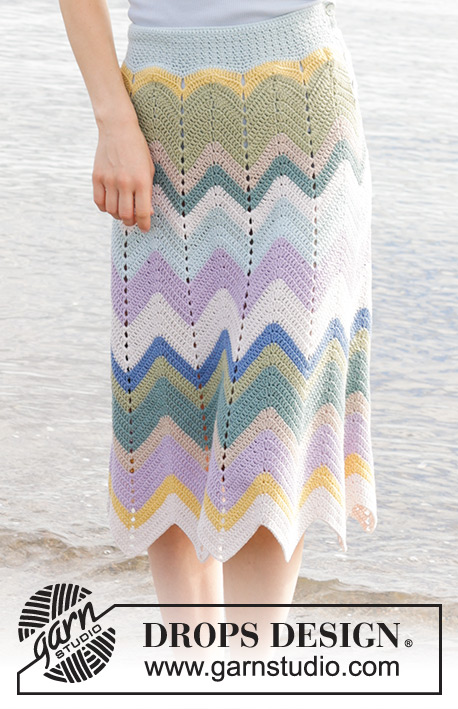 |
Crocheted skirt in DROPS Safran. The piece is worked top down with zig-zag pattern and stripes. Sizes S - XXXL.
DROPS 239-27 |
|
|
------------------------------------------------------- EXPLANATIONS FOR THE PATTERN: ------------------------------------------------------ CROCHET INFORMATION-1: Each row of double crochets turns with 1 chain stitch which does not replace the first double crochet. CROCHET INFORMATION-2: On each row of zig-zag pattern replace the first treble crochet with 3 chain stitches. The round finishes with 1 slip stitch in the 3rd chain stitch at the beginning of the round. CHAIN STITCH: If you work outermost on the hook the chain stitch will often be too tight; 1 chain stitch should be as long as 1 double/treble crochet is wide. STRIPES: NOTE! The stripes finish differently in the different sizes: 2 rows colour 62, lemon 6 rows colour 65, pistachio 2 rows colour 64, light beige 2 rows colour 63, sea green 2 rows colour 72, chalk 4 rows colour 50, mint 4 rows colour 70, sweet orchid 4 rows colour 72, chalk 2 rows colour 06, denim blue 2 rows colour 65, pistachio 4 rows colour 63, sea green 2 rows colour 64, light beige 4 rows colour 70, sweet orchid 2 rows colour 62, lemon 3 rows colour 72, chalk 2 rows colour 50, mint 2 rows colour 63, sea green 2 rows colour 64, light beige 4 rows colour 06, denim blue If all the stripes are finished, begin again from the top. DECREASE TIP: WORK 2 STITCHES TOGETHER: * Make 1 yarn over, insert the hook through the next stitch, pick up the strand and pull it through the stitch, make 1 yarn over and pull it through the first 2 loops on the hook *, work from *-* 1 more time, make 1 yarn over and pull it through all 3 loops on the hook (1 stitch decreased). WORK 3 STITCHES TOGETHER: * Make 1 yarn over, insert the hook through the next stitch, pick up the strand and pull it through the stitch, make 1 yarn over and pull it through the first 2 loops on the hook *, work from *-* 2 more times, make 1 yarn over and pull it through all 4 loops on the hook (2 stitches decreased). ------------------------------------------------------- START THE PIECE HERE: ------------------------------------------------------- SKIRT – SHORT OVERVIEW OF THE PIECE: The piece is worked top down, back and forth until the split is finished then in the round. SKIRT: Work 151-165-181-195-225-255 CHAIN STITCHES – read description above, with hook size 3.5 mm and colour mint DROPS Safran. Work 1 double crochet in the 2nd chain stitch from the hook then 1 double crochet in each chain stitch = 150-164-180-194-224-254 double crochets + 1 chain stitch – read CROCHET INFORMATION-1. Work 2 rows with 1 double crochet in each double crochet. Work the next row as follows: 2 chain stitches, skip 1 double crochet, 1 double crochet in the next double crochet, * 1 chain stitch, skip 1 double crochet, 1 double crochet in the next double crochet *, work from *-* to the end of the row = 75-82-90-97-112-127 double crochets and 75-82-90-97-112-127 chain stitches. Work the next row as follows: 2 chain stitches, skip the first double crochet and work 1 double crochet around the first chain stitch, * 1 chain stitch, skip 1 double crochet, 1 double crochet around the next chain stitch *, work from *-* to the end of the row. Repeat this last row until the piece measures 5-6-6-7-7-8 cm. REMEMBER THE CROCHET TENSION! Work 1 row with 1 double crochet in each double crochet and 1 double crochet around each chain stitch = 150-164-180-194-224-254 stitches. On the next row increase evenly as follows: * 1 double crochet in each of the 2 first double crochets, 2 double crochets in the next double crochet *, work from *-*, until there are 0-2-0-2-2-2 double crochets left, work 2 double crochets in each of these double crochets = 200-220-240-260-300-340 stitches. Work STRIPES– read description above – AT THE SAME TIME as you work zig-zag pattern back and forth as follows: ROW 1 (right side): 3 chain stitches (1 treble crochet), 1 treble crochet in each of the next 7 double crochets, * work the next 4 stitches together 2 and 2 – read DECREASE TIP, 1 treble crochet in each of the next 8 double crochets, 3 chain stitches, 1 treble crochet in each of the next 8 double crochets *, work from *-* 8-9-10-11-13-15 more times, work the next 4 stitches together 2 and 2, 1 treble crochet in each of the last 8 double crochets = 180-198-216-234-270-306 stitches. ROW 2: 3 chain stitches (1 treble crochet) + 1 treble crochet in the first treble crochet, 2 treble crochets in each of the next 2 treble crochets, 1 treble crochet in each of the next 3 treble crochets, * work the next 6 treble crochets together 3 and 3, 1 treble crochet in each of the next 6 treble crochets, 3 treble crochets around the chain-space, 3 chain stitches, 3 treble crochets around the same chain-space, 1 treble crochet in each of the next 6 treble crochets*, work from *-* 8-9-10-11-13-15 more times, work the next 6 treble crochets together 3 and 3, 1 treble crochet in each of the next 3 treble crochets and 2 treble crochets in each of the last 3 treble crochets = 200-220-240-260-300-340 stitches. ROW 3: 3 chain stitches (1 treble crochet) + 1 treble crochet in the first treble crochet, 2 treble crochets in the next treble crochet, 1 treble crochet in each of the next 5 treble crochets, * work the next 6 treble crochets together 3 and 3, 1 treble crochet in each of the next 7 treble crochets, 2 treble crochets around the chain-space, 3 chain stitches, 2 treble crochets around the same chain-space, 1 treble crochet in each of the next 7 treble crochets *, work from *-* 8-9-10-11-13-15 more times, work the next 6 treble crochets together 3 and 3, 1 treble crochet in each of the next 5 treble crochets, 2 treble crochets in each of the last 2 treble crochets = 200-220-240-260-300-340 stitches. Repeat row 3 one more time, turn. The piece measures approx. 11-12-12-13-13-14 cm. The split is finished; work the next row as follows: 3 chain stitches + 1 treble crochet in the first treble crochet, 2 treble crochets in the next treble crochet, 1 treble crochet in each of the next 5 treble crochets, * work the next 6 treble crochets together 3 and 3, 1 treble crochet in each of the next 7 treble crochets, 2 treble crochets around the chain-space, 3 chain stitches, 2 treble crochets around the same chain-space, 1 treble crochet in each of the next 7 treble crochets *, work from *-* 8-9-10-11-13-15 more times, work the next 6 treble crochets together 3 and 3, 1 treble crochet in each of the next 5 treble crochets, 2 treble crochets in each of the last 2 treble crochets on the round, 3 chain stitches, 1 slip stitch in the 3rd chain stitch at the beginning of the round = 200-220-240-260-300-340 stitches. Work the next round as follows - read CROCHET INFORMATION-2: * 1 treble crochet in each of the first 7 treble crochets, work the next 6 treble crochets together 3 and 3, 1 treble crochet in each of the next 7 treble crochets, 2 treble crochets around the chain-space, 3 chain stitches, 2 treble crochets around the same chain-space *, work from *-* to the end of the round. Continue in the round with zig-zag pattern. AT THE SAME TIME on the next round increase 2 treble crochets in each repeat by working 3 treble crochets + 3 chain stitches + 3 treble crochets around each chain-space instead of 2 treble crochets + 3 chain stitches + 2 treble crochets (increase from 10 to 11 treble crochets along each angle) = 220-242-264-286-330-374 stitches. Repeat this increase every 6th round 5 more times = 320-352-384-416-480-544 stitches (there are now 16 treble crochets along each angle). Continue working until the skirt measures 68-70-72-74-76-78 cm at the longest point. Cut and fasten the strands. BUTTON-LOOPS: Along the back of the split work a band with button-loops: Work 3 rows of double crochets and colour mint. Work 3-3-3-4-4-4 button-loops evenly on the next row: 1 button-loop = 3 chain stitches, skip 1 cm, work 1 double crochet in the next stitch. The bottom loop is 1 cm from the bottom of the split and the top loop 1 cm from the top. Work back as follows: 1 double crochet in each double crochet and 3 double crochets around each chain-space. Cut and fasten the strand. BUTTON-LINING: Along the other side of the split work 5 rows of double crochets with colour mint. Cut and fasten the strand Sew the buttons onto row 1, matching the button-loops. |
|

|
|
Have you finished this pattern?Tag your pictures with #dropspattern #reflectionsofauroraskirt or submit them to the #dropsfan gallery. Do you need help with this pattern?You'll find 12 tutorial videos, a Comments/Questions area and more by visiting the pattern on garnstudio.com. © 1982-2025 DROPS Design A/S. We reserve all rights. This document, including all its sub-sections, has copyrights. Read more about what you can do with our patterns at the bottom of each pattern on our site. |
|








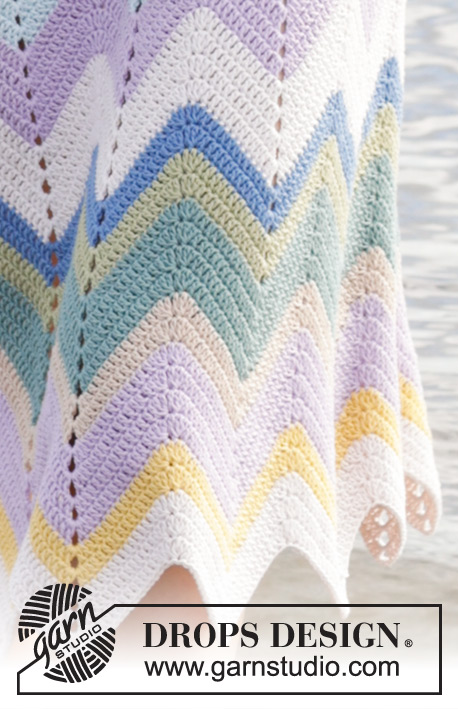

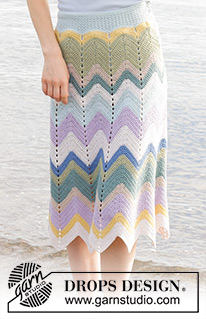
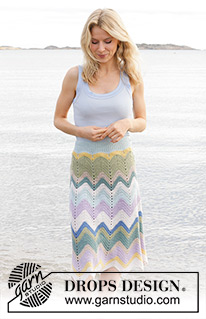
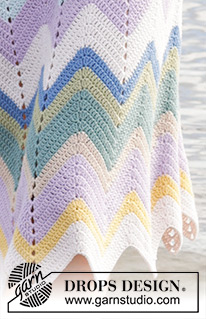


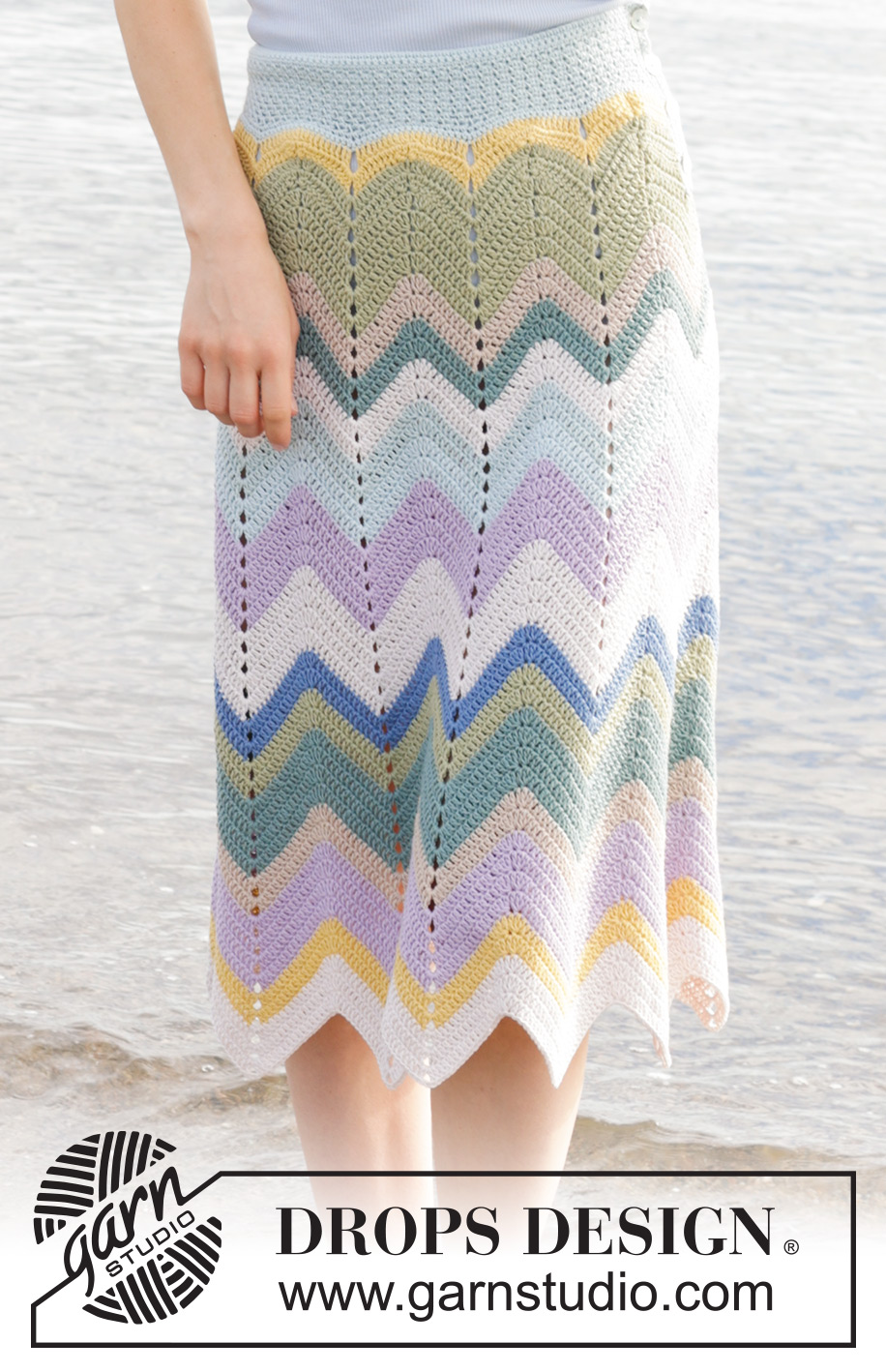
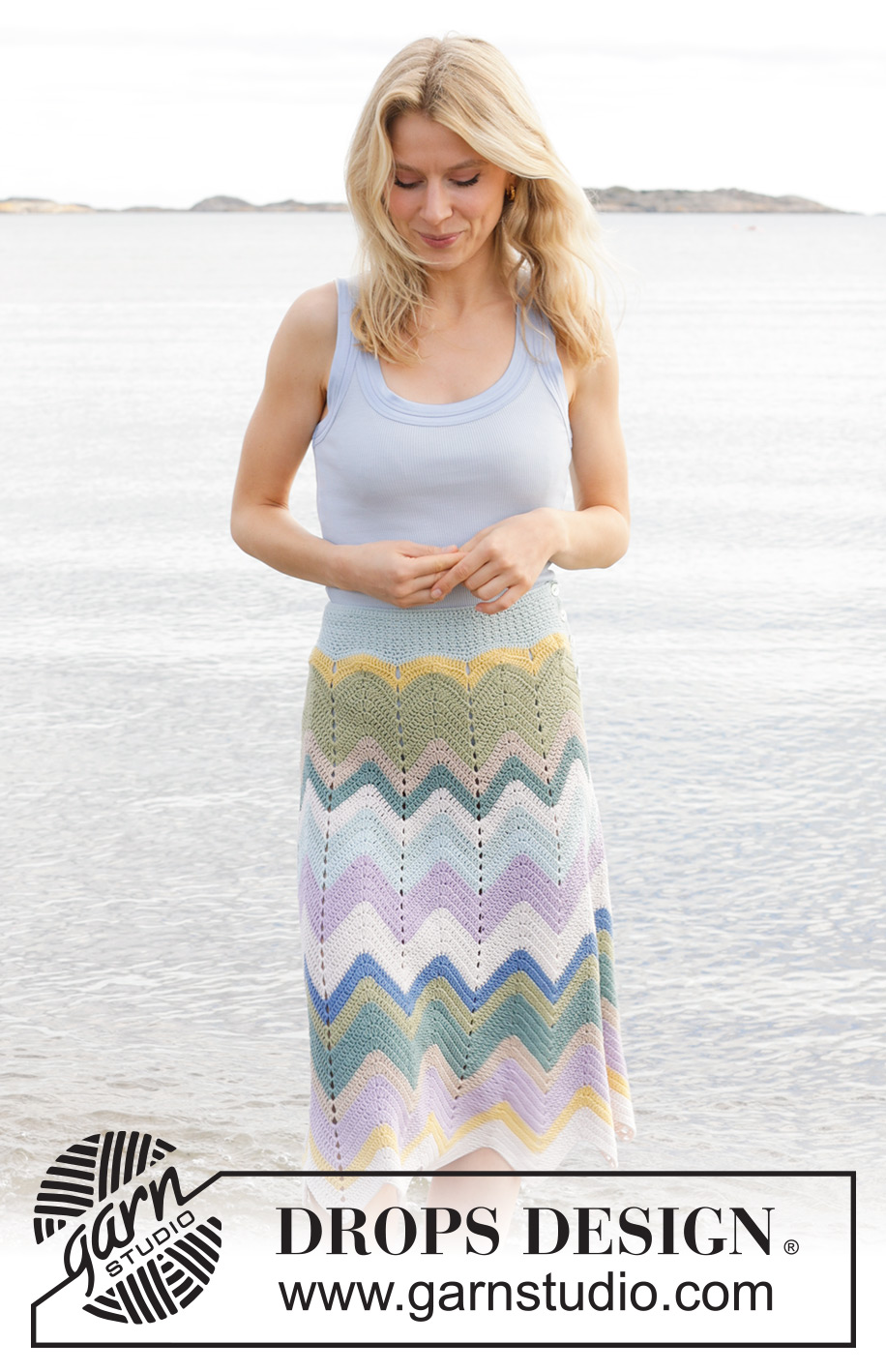
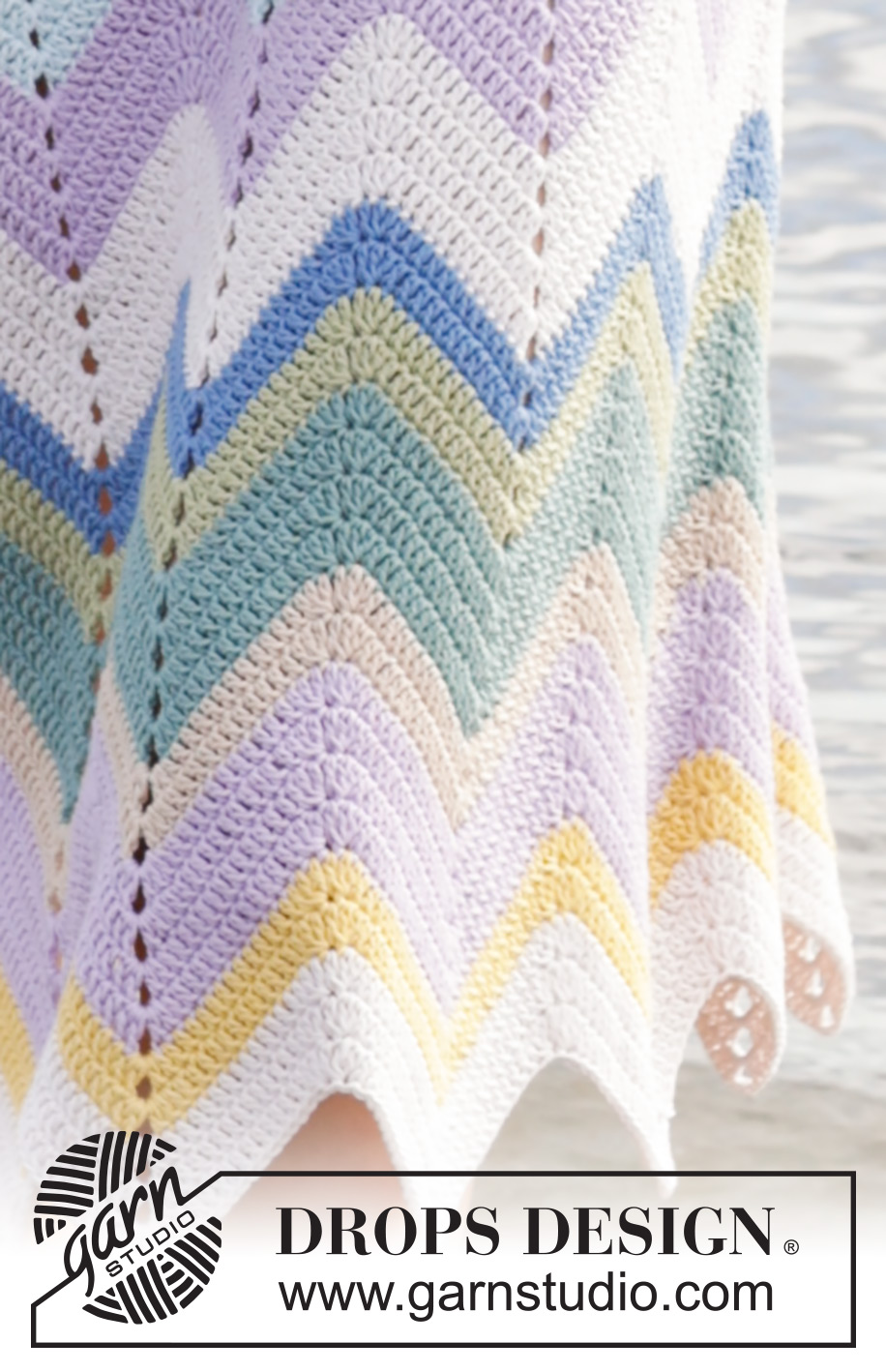




































Post a comment to pattern DROPS 239-27
We would love to hear what you have to say about this pattern!
If you want to leave a question, please make sure you select the correct category in the form below, to speed up the answering process. Required fields are marked *.